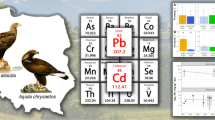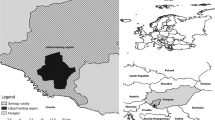Abstract
This study presents concentrations of heavy metals (iron, zinc, manganese, copper, lead, and cadmium) in livers of three owl species from Korea. Essential trace elements (iron, zinc, manganese, and copper) did not differ among the owl species. We suggest that the essential elements are within the normal range and are maintained by normal homeostatic mechanisms. Lead and cadmium concentrations in Eurasian Eagle Owls (Bubo bubo) were significantly lower than in Brown Hawk Owls (Nixos scutulata) and Collared Scops Owls (Otus lempiji). Lead and cadmium concentrations in Korean owl species were at background levels; lead concentrations in two Collared Scops Owls were above background concentrations. Lead and cadmium concentrations were similar to concentrations previously reported in owls from other parts of the world. We suggest that lead and cadmium concentrations in Korean owls are below toxic concentrations.



Similar content being viewed by others
References
Battaglia A, Ghidini S, Campanini G, Spaggiari R (2005) Heavy metal contamination in little owl (Athene noctuna) and common buzzard (Buteo buteo) from Northern Italy. Ecotoxicol Environ Saf 60:61–66
Behrens J, Brooks J (2000) Wind in their wings: the condor recovery program. Endangered Species Bull 25:8–9
Benson WW, Pharaoh B, Miller P (1974) Lead poisoning in a bird of prey. Bull Environ Contam Toxicol 11:105–108
Beyer WN, Spann JW, Sileo L, Franson JC (1988) Lead poisoning in six captive avian species. Arch Environ Contam Toxicol 17:121–130
Boncompagni E, Muhammad A, Jabeen R, Orvini E, Gandini C, Sanpera C, Ruiz X, Fasola M (2003) Egrets as monitors of trace-metal contamination in wetland of Pakistan. Arch Environ Contam Toxicol 45:399–406
Burger J, Gochfeld M (1995) Growth and behavioral effects of early postnatal chromium and manganese exposure in herring gull (Larus argentatus) chicks. Pharmaco Biochem Behav 50:607–612
Cabrera C, Ortega E, Lorenzo M, Lopez M (1998) Cadmium contamination of vegetable crops, farmlands and irrigation waters. Rev Environ Contam Toxicol 154:55–81
Cerradelo S, Muñosa S, Thomas VG, Mateo R (1999) Perdigonse y pesos de plomo: ecotoxicología y efectos para la fauna. Rev Toxicol 16:3–11
Clark AJ, Scheuhammer AM (2003) Lead poisoning in up-land-foraging Birds of Prey in Canada. Ecotoxicology 12:23–30
Clausen B, Wolstrup C (1978) Copper load in mute swans (Cygnus olor) found in Denmark. Nord Vet Med 30:260–266
Cosson RR (1989) Relationship between heavy metal and metallothionein-like protein levels in the liver and kidney two birds: the greater flamingo and the little egret. Comp Biochem Physiol 94:243–248
Custer CM, Custer TW, Michael JA, Alan DA, David EW (2003) Trace elements in Lesser Scaup (Aythya affinis) from the Mississippi Flyway. Ecotoxicology 12:47–54
Custer TW, Hohman W (1994) Trace elements in canvasbacks from Louisiana, USA: 1987–1988. Environ Pollut 84:252–259
Custer TW, Pendleton G, Ohlendorf HM (1990) Within-clutch and among clutch variation of organochlorines residues in eggs of black-crowned night herons. Environ Monit Assess 15:83–90
Dauwe T, Janssens E, Kempenaers B, Eens M (2004) The effect of heavy metal exposure on egg size, eggshell thickness and the number of spermatozoa in blue tit Parus caerulens eggs. Environ Pollut 129:125–129
Dennemen WD, Douben PET (1993) Trace metals in primary feathers o the Barn Owls (Tyto alba guttata) in the Netherlands. Environ Pollut 82:301–310
Eisler R (1985) Cadmium hazards to fish, wildlife, and invertbrates: a synoptic review. US Fish Wildl Serv. Biol. Rep. 85(1.2):85
Eisler R (2000) Handbook of chemical risk assessment-health hazards to humans, plants, and animals. Vol. 1. Metals. Florida. Lewis Publishers, New York
Elliot JE, Scheuhammer AM, Leighton FA, Pearce PA (1992) Heavy metals and metallothionein concentrations in Atlantic Canadian seabirds. Arch Environ Contam Toxicol 22:63–73
Esselink H, Van der Geld FM, Jager LP, Posthuma-Trumpie GA, Zoun PEF, Baars AJ (1995) Biomonitoring heavy metals using the barn owl (Tyto alba guttata): Sources of variation especially relating to body condition. Arch Environ Contam Toxicol 28:471–486
Franson JC (1996) Interpretation of tissue lead residues in birds other than waterfowl. In: Beyer WN, Heinz GH, Redmon-Norwood AW (eds) Environmental contaminants in wildlife, interpreting tissue concentrations, CRC Press Lewis Pub, New York, pp 265–279
Franson JC, Koehl PS, Derksen DV, Rothe TC, Bunck CM, Moore JF (1995) Heavy metals in seaducks and mussels from Misty Fjords National Monument in southeast Alaska. Environ Monit Assess 36:149–167
Furness RW (1996) Cadmium in birds. In: Beyer WN, Heinz GH, Redmon-Norwood AW (eds) Environmental Contaminants in Wildlife. CRC Press Lewis Pub, Boca Raton, FL, pp 389–404
Furness RW, Greenwood JJD (1993) Birds as monitors of environmental change. Chapman & Hall. pp 102–120
García-Fernández AJ, Motas-Guzmán M, Navas I, María-Mojica P, Luna A, Sánchez-García JA (1997) Environmental exposure and distribution of lead in four species of raptors in Southeastern Spain. Arch Environ Contam Toxicol 33:76–82
García-Fernández AJ, Sánchez-García JA, Jiménez P, Luna A (1995) Lead and cadmium in wild birds in Southeastern Spain. Environ Toxicol Chem 14:2049–2058
Gasaway WC, Buss IO (1972) Zinc toxicity in the mallad duck. J Wildl Manage 36:1107–1117
Goyer RA (1995) Nutrition and metal toxicity. Am Clin Nutr 61(Suppl):646–650
Guitart R, Mañosa S, Thomas VG, Mateo R. (1999) Perdigones y pesos de plomo: ecotocicología y efectos para la fauna. Rev Toxicol 16:3–11
Henny CJ, Blus LJ, Hoffman DJ, Grove RA (1994) Lead in hawks, falcons and owls doenstream from a mining site of the Coeur d’Alene river, Idaho. Environ Monit Assess 29:267–288
Henny CJ, Blus LJ, Hoffman DJ, Grove RA, Hatfield JS (1991) Lead accumulation and osprey production near a mining site on the Coeur d’Alene river, Idaho. Arch Environ Contam Toxicol 21:415–424
Henny CJ, Rudis DD, Roffe TJ, Robinson-Wilson E (1995) Contaminants and sea ducks in Alaska and the circumpolar region. Environ Health Perspect 103:41–49
Hernández M (1995) Lead poisoning in a free-ranging imperial eagle. Suppl J Wildl Disea 31, Newsletter
Honda K, Marcovecchio JE, Kan S, Tatsukawa R, Ohi H (1990) Metal concentrations in pelagic seabirds from the North Pacific Ocean. Arch Environ Contam Toxicol 19:704–711
Honda K, Min BY, Tatsukawa R (1986) Organ and tissue distribution of heavy metals, and age-related changes in the Eastern Great White Egret Egretta alba modesta in the Korea. Arch Environ Contam Toxicol 15:185–197
Honda K, Tatsukawa R, Fujiyama T (1982) Distribution characteristics of heavy metals in the organs and tissues of striped dolphin, Stenella coeruleoalba. Agric Biol Chem 46:3011–3021
Hothem RL, Lonzarich DG, Takekawa JE, Ohlendorf HM (1998) Contaminants in wintering canvasbacks and scaups from San Francisco Bay, California. Environ Monit Assess 50:67–84
Hutton M, Goodman GT (1980) Metal contamination of feral pigeons from London area: Part I. Tissue accumulation of lead, cadmium, and zinc. Environ Pollut 22:207–217
Jager LP, Rijnierse FVJ, Esselink H, Baars AJ (1996) Biomonitoring with the buzzard Buteo buteo in the Netherlands: heavy metals and sources of variation. J Ornithol 137:295–318
Janssen DL, Dauwe T, Pinxten R, Bervoets L, Blust R, Eens M (2003) Effects of heavy metal exposure on the condition and health of nestling of the great tit (Parus major), a small songbirds species. Environ Pollut 126:267–274
Janssen DL, Oosterhus JE, Allen JL, Anderson MP, Kelts DG, Wiemeyer SN (1986) Lead poisoning in free ranging California Condors. J Am Vet Med Assoc 189:1115–1117
Keen CL, Lonnerdal B, Hurley LS (1984) Manganese. In: Biochemistry of the Essential Ultratrace Elements. Plenum Press, New York, pp 89–132
Kenntner N, Tataruch F, Krone O (2001) Heavy metals in soft tissues of white-tailed eagles found dead or moribund in Germany and Austria from 1993 to 2000. Environ Toxicol Chem 20:1831–1837
Kim EY, Goto R, Iwata H, Masuda Y, Tanabe S, Fujita S (1999) Preliminary survey of lead poisoning of Stellar’s sea eagle (Haliaeatus pelagicus) and white-tailed eagle (Haliaeatus albicilla) in Hokkaido, Japan. Environ Toxicol Chem 18:448–451
Kim E-Y, Ichihashi H, Saeki K, Atrashkevich G, Tanabe S, Tatsukawa R (1996) Metal accumulation in tissues of seabirds from Chaun, Northeast Sibaria, Russia. Environ Pollut 92:247–252
Kim J, Koo T-H (2007) Heavy metal concentrations in diet and livers of Black-crowned Night Heron Nycticorax nycticorax and Grey Heron Ardea cinerea chicks from Pyeongtaek, Korea. Ecotoxicology 16:411–416
Kim JS, Lee D-P, Koo T-H (2000) A comparative study of heavy metal concentration between chick and adult of Black-crowned Night Heron Nycticorax nycticorax. Korean J Ornithol 7:33–41
Kim S-J, Lee J-N, Lee D-P (2006) Cadmium and lead levels of loons wintering in Korea. J Ecol Field Bio 29:539–543
Kim J, Park S-K, Koo T-H (2007) Trace elements and pollutants concentrations in shorebirds from Yeongjong Island, Korea in the East Asian-Australian Migration Flyways. Ecotoxicology 16:403–410
Kramer JL, Redig PT (1997) Sixteen years of lead poisoning in eagles, 1980–95: an epizootiologic view. J Raptor Res 31:327–332
Lee DP, Honda K, Tatsukawa R (1987) Comparison of Tissue Distribution of Heavy Metals in Birds in Japan and Korea. J Yamashina Inst Ornithol 19:103–116
Lee W-S, Koo T-H, Park J-Y (2000) A field guide to the birds of Korea. LG Evergreen Foundation. pp 184–189
MacDonald JW, Randall CJ, Ross HM, Moon GM, Ruthven A (1983) Lead poisoning in captive raptors. Vet Rec 113:65–66
Martin MB, Reiter R, Pham T, Avellanet YR, Camara J, Lahm M, Pentecost E, Pratap K, Gilmore BA, Divekar S, Dagata RS, Bull JL, Stoica A (2003) Estrogen-like activity of metals in Mcf-7 breast cancer cells. Endocrinology 144:2425–2436
Mateo R, Molina R, Grífols J, Guitart R (1997) Lead poisoning in a free-ranging griffon vulture (Gyps fulvus). Vet Rec 140:47–48
Mateo R, Taggart M, Meharg AA (2003) Lead and arsenic in bones of birds of prey from Spain. Environ Pollut 126:107–114
Meretsky VJ, Snyder NFR, Beissinger SR, Clendenen DA, Wiley JW (2000) Demography of the California Condor: implications for reestablishment. Conserv Biol 14:957–967
Nam D-H, Lee D-P (2006) Reproductive effects of heavy metal accumulation on breeding feral pigeons (Columba livia). Sci Total Environ 366:682–687
NRC (National Research Council) (1991) Animals and sentinels of environmental health hazards. National Academic Press, Washington, D.C
Pain DJ, Amiard-Triquet C (1993) Lead poisoning of raptors in France and elsewhere. Ecotoxicol Environ Saf 25:183–192
Pain DJ, Sears J, Newton I (1995) Lead concentrations in birds of prey in Britain. Environ Pollut 87:173–180
Pattee OH, Hennes SK (1983) Bald eagles and waterfowl: the lead shot connection. Trans Am Wildl Nat Resour Conf 48:230–237
Platt JB (1976) Bald eagles wintering in a Utah desert. Am Birds 30:783–788
Puls R (1994) Mineral levels in animal health: diagnostic data 2nd edn. Sherpa International, British Columbia
Redig PT, Stowe CM, Barnes DM, Arent TD (1980) Lead toxicosis in raptors. J Am Vet Med Assoc 177:941–943
Scheuhammer AM (1987) The chronic toxicity aluminium, cadmium, mercury and lead in birds: a review. Environ Pollut 46:263–295
Scheuhammer AM, Norris SL (1996) The ecotoxicology of lead shot and lead fishing weights. Ecotoxicology 5:279–295
Schilderman PAEL, Hoogewerff JA, Schooten F-J, Maas LM, Perspect EJC, Os BJH, et al (1997) Possible relevance of pigeons as an indicator species for monitoring air pollution. Environ Health Perspect 105:322–329
Sever C (1993) Lead and outdoor ranges. In: National shooting range symposium proceedings. Salt Lake City, Utah, October 17–19, pp 87–94
Stock M, Herber RFM, Geron HMA (1989) Cadmium levels on oystercatcher Haematopus ostralegus from German Wadden Sea. Mar Ecol Prog Ser 53:227–234
Stoica A, Katzenellenbogen BS, Martin MB (2000) Activation of estrogen receptor-α by the heavy metal cadmium. Mol Endocrinol 14:545–553
Stout JH, Trust KA, Cochrane JF, Suydam RS, Quakenbush LT (2002) Environmental contaminants in for eider species from Alaska and arctic Russia. Environ Pollut 119:215–226
Takekawa JY, Wainwright-De la Cruz SE, Hothem RL, Yee J (2002) Relating body condition to inorganic contaminant concentrations of diving ducks wintering in coastal California. Arch Environ Contam Toxicol 42:60–70
Trust KA, Rummel KT, Scheuhammer AM, Brisbin IL Jr, Hooper MJ (2000) Contaminants exposure and biomarker responses in spectacled eiders (Somateria fischeri) from St Lawrence Island, Alaska. Arch Environ Contam Toxicol 38:107–113
Acknowledgements
All samples were provided by the Conservation Genome Resource Bank for Korean Wildlife (CGRB), with thanks. We are grateful to Thomas W. Custer (USGS) for a critical reading and comments of the manuscript.
Author information
Authors and Affiliations
Corresponding author
Rights and permissions
About this article
Cite this article
Kim, J., Lee, H. & Koo, TH. Heavy-metal concentrations in three owl species from Korea. Ecotoxicology 17, 21–28 (2008). https://doi.org/10.1007/s10646-007-0172-y
Received:
Accepted:
Published:
Issue Date:
DOI: https://doi.org/10.1007/s10646-007-0172-y




